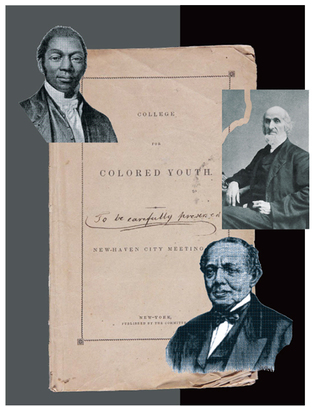
Collage: Jeanine Dunn. Pamphlet: Yale University Library. Pennington: Massachusetts Historical Society.
An 1831 pamphlet documents the debate over the proposal for a Black college in New Haven. Among its proponents were (clockwise from top left) James Pennington, Simeon Jocelyn, and William Whipper.
View full image
The Black college that might have been
Reformer and abolitionist Simeon Jocelyn was the pastor at Temple Street Church—now Dixwell Avenue Congregational—in New Haven. In 1831, Jocelyn had the idea to build a college for freed people of color in New Haven. He took the idea to Peter Williams, a key Black leader in New York City, and a then-little-known abolitionist named William Lloyd Garrison. They enlisted the support of Arthur Tappan, a wealthy businessman from New York with a home in New Haven, and took their proposal to the First Annual Convention of the People of Colour. Its leadership included important free Black leaders such as William Whipper, Samuel Cornish, and James Pennington.
Jocelyn, Garrison, and Tappan wanted a college that would provide a scientific and agricultural education, a mechanical education—a practical education. The Black and white allies wanted to establish the college as soon as they could raise $20,000. They chose New Haven for several reasons: it was a beautiful place, apparently cheap in terms of boarding and provisions. Connecticut’s laws were “salutary and protecting to all, without regard to complexion,” and the New Haven residents seemed “friendly, pious, generous, and humane.” They thought Yale had created a “literary and scientific character” in the city that would support the college intellectually. Also, New Haven had ties to the West Indies, which might turn the college into a hub of Black learning for freed people from across the Atlantic.
The Colored Convention thought the school was a wonderful idea and started raising funds. The problem: Jocelyn and Garrison had severely misjudged the character of New Haven. On September 10, the mayor convened a town meeting. The college was voted down by a vote of 700 to 4.
Because a committee drew up resolutions against the college, we have a decent sense of why they opposed it. Six of the ten people on the committee were Yale graduates and prominent New Haveners (including three founders of Yale Law School). They argued that New Haven already had institutions of learning—Yale and a women’s school—and that a college for freed people would be “destructive of the best interests of the city.” This was likely a euphemism for their real fear: race mixing.
The other argument, just as spurious, was that although slavery was gradually being abolished in Connecticut, it was legal in other states, and the college would be a step toward emancipation that might incite slaves in slaveholding states to rebellion. This, they said, would be completely irresponsible.
There was irresponsibility, but from the other side. The college proposal sparked an active and violent anti-abolition element in the city. A mob descended on Tappan’s house; one Black person’s house was “leveled to the ground,” and another Black man was “knocked down in the streets.” Jocelyn would eventually be driven out of the city. And the idea of the college basically died. Jocelyn, Tappan, Garrison, and the Colored Convention tried to keep it alive for a year or two, but the momentum was gone. Fundamentally, the story of the New Haven Black college is the story of a project that failed.
But I would describe the proposal as a landmark moment in the history of abolitionism, because it forced people to make a choice. At the time, the white anti-slavery coalition aligned mostly with the idea of colonization: removing free Black people from the US. It had the support of a number of Southern slaveholders, and it was decidedly racist. It assumed Black inferiority. It also advocated gradual emancipation—but only if emancipation meant forcing enslaved people to leave the US.
Black abolitionists, of course, had been inveighing against colonization for years. Their activism was a driving force in the eventual turn against deporting Black people. The college proposal supported this idea. It assumed that Black people would eventually be free and equal citizens with a right to an education. It was a stark departure from the default position of many anti-slavery types—including such Yale faculty as the scientist Benjamin Silliman and the theologian Leonard Bacon. Even as just an idea, the college forced people to decide where they stood.
Finally, I think it’s no coincidence that in 1833, many of the same Black leaders, and their white allies from the college effort, would meet in Philadelphia and found the American Anti-Slavery Society: a radical interracial organization that condemned slavery and demanded its immediate abolition. It was the first such organization in American history.
Bennett Parten ’23PhD is a doctoral candidate in history.
 loading
loading